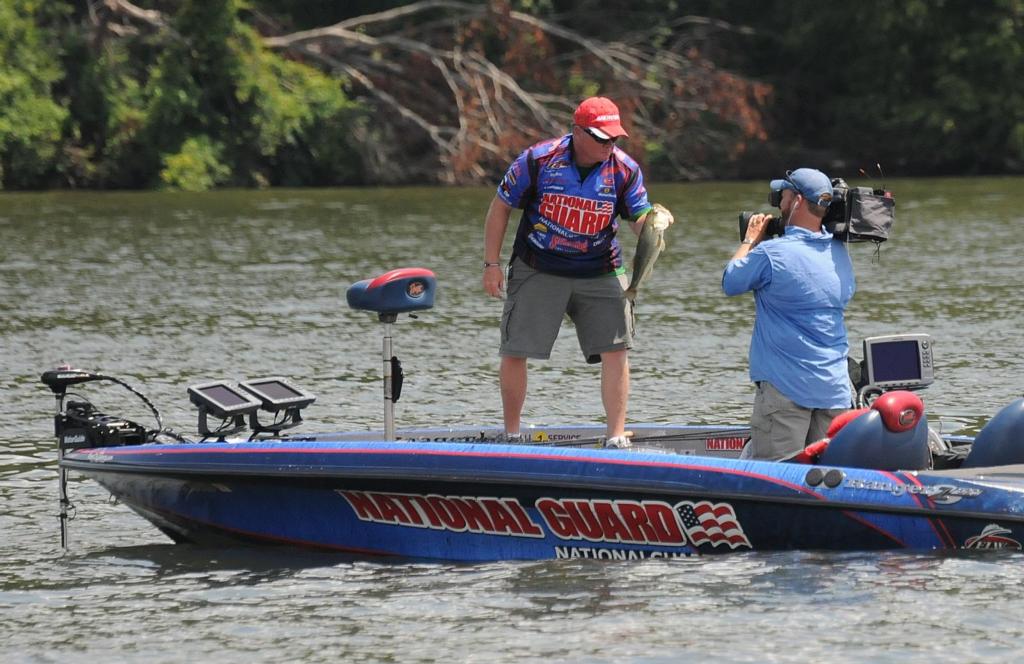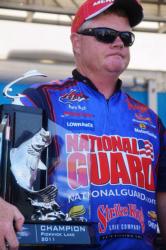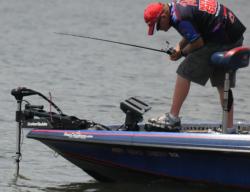Reel Chat with MARK ROSE
National Guard pro discusses his third Pickwick victory, chances at the Cup, search methods, baits, co-angler advice and much more

– MODERATOR COMMENT –
Welcome to FLW Live Reel Chat. Today we’re joined by bass pro Mark Rose of Marion, Ark., who recently won the FLW Tour title at the July 21-24 Pickwick Lake event.
– MODERATOR COMMENT –
With nearly $1.37 million in winnings and 28 top-10 finishes at FLW Outdoors-related events since 1996, Mark Rose of Marion, Ark., finally secured his first-ever FLW Tour win at Pickwick Lake on July 24. The National Guard pro, who has a remarkable 13 top-10 finishes on the FLW Tour since the 1999 season, has now won three tournaments on Pickwick Lake in the last four years including a 2007 FLW Series win, a 2009 EverStart Series Championship win as well as his most recent Tour victory in late July. Rose also has finished in third place overall in the FLW Tour Angler of the Year race for two consecutive seasons and will be participating in this year’s Forrest Wood Cup at Hot Springs, Ark., from Aug. 11-14.
– MODERATOR COMMENT –
Today, Rose is here to take questions from you, the fans. So, without further delay, let’s get started.
Q (MODERATOR): What did it feel like to get your first-ever FLW Tour victory?
A: You know, it really didn’t feel any more special than any of my other wins. When I won the FLW Series, it was basically the same type of field. But anytime you win against this type of field, it’s great. Personally, I don’t chase titles. I just go out and do my best and see what happens. I’m more thankful for my sponsors, the National Guard and for my family.
Q (MODERATOR): I believe you said in an interview that on the final day, at around noon, you felt like the tournament might be “slipping away.” How nervous were you at that point, and how did you finally turn things around on Pickwick Lake that afternoon?
A: I got to tell you, I blasted off that morning and didn’t think anything could shake me. I really know Pickwick Lake, and I thought everything was going to fall into place. But I’ll tell you, at about 12:30 I started thinking, “Surely, you’re not going to blow this big opportunity.” But later in the day I got some current, knew where I needed to be and was able to catch some fish. If I was on a different lake, I might have been more nervous. But deep down inside, I knew it was going to happen.
Q: Do you always look for fish with your electronics prior to fishing a ledge/strucure, and if so, what are you looking for (arches, position in relation to the bottom, shad, etc.)?
— David (Fayette, Ala.)
A: Most of the time in pre-practice when ledge fishing, I always try to find groups of fish with my electronics. When practicing I do a lot of looking at my electronics and a lot less fishing. Sometimes I won’t even make a cast until the tournament starts. I look for schools of fish all the time on my graph. When you see fish high in the water column, they’re usually not bass. But when you see the fish on the bottom, little white dots on the graph, you’ll usually find bass. When you look at your graph long enough, you’ll be able to distinguish between those different types of white dots — whether or not they’re bass or baitfish.
Q: After Pickwick another site quoted you as saying “understand how to read the fish on my graphs — the way they look when I see them, and what I need to throw to catch them. People think it’s a magic lure or something, but it’s a combo of a lot of different lures.” Can you share some more details about what you look for on your graph to determine which baits to throw? Is it  as simple as bottom baits when they are tight to the bottom? Thanks!
as simple as bottom baits when they are tight to the bottom? Thanks!
— D. Jenkins (St. Leonard, Md.)
A: You hit the nail on the head. When I see that the fish are low in the water column and not bouncing around on my graph, then I throw more bottom-type baits: big worm, football jig or grinding my crankbait low. If I see them higher in the water column, that’s when I’ll throw a spoon, start burning a crankbait through them, throw swimbaits. If I can get those fish to come up, I can usually get those fish to commit. I’ll throw a hair jig in that situation as well.
Q: Congrats on your win, Mark. There are miles of good-looking ledges on Pickwick. How do you narrow down possible productive spots on a map before you arrive at the lake? What stands out to you on some of these spots? When graphing these areas, are you looking for baitfish, bass or a combination of both?
— Scott (Oakland, Tenn.)
A: Scott, a couple of years ago I’d probably have looked towards the more obvious places — tips, points or indentations. But now, as many ledge fishermen as there are out there, I’m now looking for more subtle stuff like straight-aways or flats. If you fish on a low-pressure lake, look for those tips, indentations and sweet spots. But if the lake is heavily pressured, fish the non-obvious stuff because the local will have pushed those fish to non-obvious places. And if you look hard enough, you’ll find the mother lode.
Q: Mark, how were you able to locate a nice school of fish without running all over the TVA river system?
— Darrell Denton (Tupelo, Miss.)
A: There are always certain areas of the lake that are always going to have some fish. This particular area I fished is known for having good fish. But I went looking for a more subtle area. I wound up finding a 25-foot hole where the fish went because (angler fishing pressure) had pushed them there.
Q: Mark, congrats on your first Tour victory. Describe how your faith in “the Man” and “the Master” (as you put it) has guided you through your ups and downs of fishing professionally. Thank you for your witness and being a class act. Good luck in the Cup!
— Jonathan (Murray, Ky.)
A: Well, anybody that knows me knows where my strength, power and wisdom come from. I live out my faith when I’m fishing. So much of fishing is out of my control, and I just have a motto where I fish as hard as I can and try to honor God as much as I can and leave the results up to him. He’s proven time and time again that he’s been there for me in my career. My career is what it is now because of what he’s done for me in so many ways.
Q: Dear Mr. Rose, I was wondering how you break down and fish different bodies of water like natural lakes, reserviors, canyon lakes, rivers, etc. throughout the season. At my last junior club meeting, I learned that in the summer on natural lakes you should focus your efforts on deep weedlines, matted cover and docks. Could you please expand on this and briefly explain how you would fish the other bodies of water?
— Josh S. (Brookfield, Wis.)
A: Growing up on the Mississippi Delta, I was a bubba bait fisherman: big bait and big line. I had to go up north and fish for a totally different species than what I was used to. A lot is trial and error, getting beat and learning why I got beat. There are general rules of thumb, but there is more to it than that. Basically it’s going out and doing your best with what you know. Sometimes you might hit the nail on the head and guess right. But I had to learn how to go south and fish Okeechobee. I learned how to fish vegetation there, and that vegetation was key. When you learn different water-level clarities, baits and techniques, you’ll start to understand how to become a better fisherman. But I still have weaknesses that I’m working on, so the learning never stops.
Q: Congrats, Mark! How are you feeling about the Forrest Wood Cup? Being the dog days of summer, how do you prepare for a tournament like that? Do you think that a lot of the fish will be suspended, and are you planning to fish deep?
— Omar (Ashland City, Tenn.)
A: The way I’m preparing, you really need to think about your physical condition heading into a tournament like that. I’m getting up early, drinking a lot of water and really exercising. When I get there, I think there are going to be lots of suspended fish because I think there will be a thermocline. You’ll need to find out where most of the oxygen is to fish at the right depth.
Q: When you determine that there are fish in an area, how do you generally go about picking that structure apart? Do you have a systematic approach (rotation of baits, line size, etc.)?
— David (Fayette, Ala.)
A: Variables come into play with how I approach which baits to throw: wind, current, water clarity and how the fish are positioned on my graph. Again, I always try to go active right out of the gait with active, fast-moving  baits. Then I’ll try to slow things down.
baits. Then I’ll try to slow things down.
Q: Congrats on your win! How was it not having your practice partner with you at Pickwick? I thought it might have put you at a disadvantage — ha.
— Rob Hicks (Lula, Ga.)
A: I really missed my practice partner at Pickwick. My partner actually helps me more than he thinks. But I totally understand the reason my practice partner had to miss that tournament, and I respect him for it.
Q: Mark, from one Christian to another, congrats on another win. I know you give the lord all the praise, and you should! What was you No. 1 choice of bait for the tournament? What kind of structure were you fishing?
— Cody Hanley (Utopia, New Brunswick, Canada)
A: Structure was strictly river ledges with shell bottoms. I also had kind of a one-two punch as far as baits go. When there was current, I used a combination of Strike King 3/4-ounce football jigs in the Plum Crazy color, Strike King Sexy Spoons and a swimbait. When there was less current, I could catch them on a Strike King 3/16-ounce Shaky Head and a 10-inch worm.
Q: How important is lure color at Pickwick this time of year?
— James (Pontotoc, Miss.)
A: I think lure color is very important. On Pickwick Lake the green-pumpkin and plum colors have been a mainstay for me — they just work so well. You’ll see later this year that Strike King will come out with a new Plum Crazy color — combining my two favorites, plum and green-pumpkin.
Q: Hi, Mark. Congrats on the win. My question is this: What type of hook do you use on a Texas rig, and what knot do you prefer? Thanks.
— Peter (Copperas Cove, Texas)
A: Strike King has just come out with a Hack Attack flipping hook that I really prefer on my Texas rig. And I mostly tie a palomar knot.
Q: In one of your interviews at Pickwick, you stated that you knew what lures to throw based on how the fish were positioned on your depth finder. Please expand on that and describe what you see different in a school that is actively feeding versus fish that are just hanging out.
— Scott (Oakland, Tenn.)
A: Actively feeding fish are fish that are jumping around on your screen. When you see them like that, you know they’re catchable.
Q: How do you know when to stay put and fish an area or beat the bank? Does it depend on the time of year you are fishing?
— David Medler (Pottsboro, Texas)
A: It does depend on the time of year you’re fishing. When the fish are on the banks in the spring and the fish are spawning, you need to be on the banks. But even then you need to look for good, hard bottoms and visible cover. Then you gradually pull out as the water gets hotter, unless you have lots of shallow vegetation to keep them there.
Q (MODERATOR): As an Arkansas native, how do you size up your chances at this year’s Forrest Wood Cup tourney on Lake Ouachita?
A: Well, I will admit that Ouachita is not one of my stronger lakes. And I only fish it when a big tournament comes there. I haven’t fished it a bunch even though I live in Arkansas. Another negative for me is that I don’t like deep, clear grass lakes. But I’ve fished enough to understand what it takes to win there, so hopefully I can make those adjustments and do well there this year.
Q: Great job at Pickwick! What electronic setup do you have on your boat? It looks like you have two HDS-10s up front.
— Brad (Loudon, Tenn.)
A: That is correct. In addition, on my console I have an HDS-8 in the dash and an HDS-10 on my RAM mount.
Q: What advice do you give your co-anglers when fishing ledges with you?
— Omar (Ashland City, Tenn.)
A: Try not to throw 2 inches from where I’m throwing — because those fish run in packs, and the sweet spot might move from where I think it is. By throwing to different spots, we can work as a team and fan-cast. Sometimes by doing that you can help each other out. Also, using different techniques from your pros can be a help. On Pickwick, one day, my co-angler used another bait and wound up catching a lot of quality fish. And he eventually won the tournament. But had he used the same bait as I was using, he might not have done nearly as well.
– MODERATOR COMMENT –
Unfortunately, that’s all the time we have to chat with Mark today. Thanks, once again, to all the fans who tuned in and participated in today’s Reel Chat. And a special thanks to National Guard team pro Mark Rose, the recent FLW Tour winner on Pickwick Lake, for giving us his time and insights into bass fishing. Check back shortly for a complete transcript of today’s FLW Live Reel Chat.